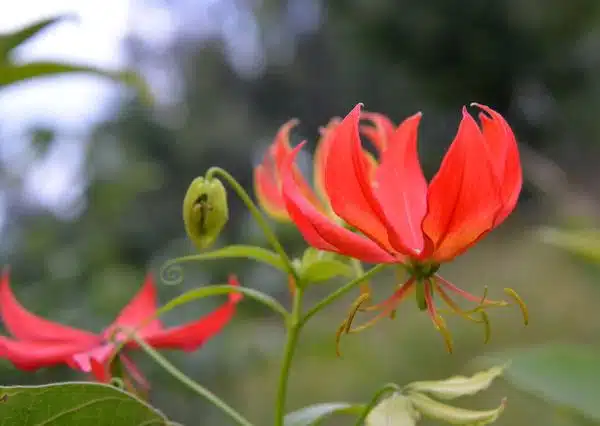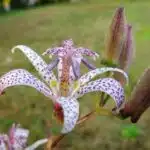Gloriosa Lily, also known as Flame Lily or Glory Lily, is a stunningly beautiful flowering plant that belongs to the family Colchicaceae. Originating from tropical regions of Africa and Asia, this climbing vine is now popularly grown in gardens across the world as an ornamental plant. Its vibrant red and yellow flowers are a sight to behold and can add an exotic touch to any garden or indoor space.
However, growing and caring for Gloriosa Lily can be challenging for those who are not familiar with its specific needs. In this article, we will provide you with comprehensive guidance on how to grow and care for Gloriosa Lily. From choosing the right soil type and watering schedule to providing adequate support for its vines and protecting it from pests and diseases, we will cover all aspects of this beautiful plant’s cultivation. Whether you are a seasoned gardener or a beginner looking to expand your horticultural skills, this guide will help you successfully grow and enjoy the beauty of Gloriosa Lily in your home or garden.
Understanding Gloriosa Lily’s Origin And Characteristics
Imagine a plant that embodies the very essence of elegance, sophistication, and grace. A plant whose beauty is matched only by its symbolism. This is what the Gloriosa Lily represents. Hailing from tropical regions of Africa and Asia, this magnificent plant has been admired for centuries for its stunning appearance and unique characteristics.
The Gloriosa Lily is known for its vibrant colors that range from deep reds to bright yellows. Its petals are long and curved, giving the flower an unmistakable flame-like look that sets it apart from other lilies. It’s no wonder that this plant has become a symbol of passion, ambition, and love in many cultures around the world.
Apart from its symbolism, the Gloriosa Lily possesses some unique characteristics that make it stand out among other flowers. Unlike most lilies that grow from bulbs, this plant grows from tubers. The tubers have a distinct shape resembling a claw or tendril which gives them their nickname of “climbing lily.” Additionally, this plant can climb up to 8 feet tall with the help of tendrils on its leaves which wrap around objects to support it as it grows.
Choosing The Right Soil Type
Soil composition is critical when it comes to growing and caring for gloriosa lilies. The right soil type ensures that the plant is healthy and grows to its full potential. When selecting soil for gloriosa lily, consider light, well-draining soil with a pH balance between 6.0-6.5.
The ideal soil composition for gloriosa lilies should be rich in organic matter and provide adequate drainage. This allows water and nutrients to reach the roots without causing waterlogging or other issues that may affect the health of the plant. Soil with good drainage also prevents root rot, which is one of the most common problems with growing these plants.
To determine if your soil has the right pH balance for growing gloriosa lilies, use a soil test kit. If your soil’s pH level is outside of the recommended range, you can amend it by adding lime or sulfur. Preparing your soil correctly is crucial to ensuring your gloriosa lilies thrive in their environment and produce beautiful blooms year after year.
Preparing The Soil For Planting
After choosing the right soil type for your gloriosa lily, it’s essential to prepare the soil for planting. One of the first steps in preparing the soil is mixing additives into the soil. Additives such as compost, manure, and perlite can help improve drainage and aeration in heavy clay soils. On the other hand, peat moss can help retain moisture in sandy soils.
Another crucial step in preparing the soil for planting is testing its pH level. Gloriosa lilies prefer slightly acidic to neutral soils with a pH range between 5.5 and 7.0. If your soil’s pH level is too low or high, it can cause nutrient deficiencies that can affect plant growth and flowering. You can test your soil’s pH level using a simple home testing kit or by sending a sample to a local agricultural extension office.
In summary, preparing the soil for planting gloriosa lilies involves mixing additives into the soil and testing its pH level. By doing so, you’ll create an ideal growing environment that will promote healthy root development and optimal plant growth. In the next section, we’ll discuss selecting the best location for your gloriosa lily to ensure that it receives adequate sunlight and protection from environmental stressors.
Selecting The Best Location For Gloriosa Lily
As the majestic and exotic Gloriosa Lily is a tropical plant, it requires specific growing conditions to thrive. Selecting the ideal location for planting this lily is crucial in ensuring its healthy growth. The first factor to consider is the ideal climate for this plant.
Gloriosa Lilies thrive in warm, humid environments with temperatures ranging from 60-80°F (15-27°C). It is important to note that they are sensitive to frost and should be planted after the last frost date. In addition, these lilies require well-draining soil to prevent root rot. Potential challenges that may arise when choosing a location include extreme temperature changes or prolonged periods of drought.
To simplify the selection process of an ideal location for your Gloriosa Lily, refer to the table below. This table provides an overview of what factors to consider and what conditions are suitable for optimal growth.
| Factors | Suitable Conditions |
|---|---|
| Temperature | 60-80°F (15-27°C) |
| Soil Type | Well-draining |
| Moisture | Consistent watering schedule |
| Light Exposure | Partial shade |
In selecting an appropriate location for your Gloriosa Lily, it is important to evaluate potential challenges that may hinder its growth. By providing adequate sunlight exposure, you can help your plant grow strong and healthy.
Providing Adequate Sunlight
After selecting the best location for your gloriosa lily, it is important to provide adequate sunlight for optimum growth. This plant requires plenty of direct sunlight to thrive and should be planted in a spot that receives at least six hours of sun each day. However, it can also tolerate some shade if needed.
Sunlight duration is an important factor when growing gloriosa lilies. These plants require a lot of sun to produce their vibrant blooms, so it is essential to make sure they are planted in a sunny location. If you live in an area with hot summers, it may be necessary to provide some shade during the hottest part of the day to prevent wilting.
While gloriosa lilies prefer full sunlight, they can also tolerate some shade. If you live in an area with limited sunlight, consider planting your gloriosa lily in a partially shaded location. This will help protect the plant from intense heat and ensure that it receives enough light to grow and bloom. Overall, providing adequate sunlight is crucial for growing healthy and beautiful gloriosa lilies.
As we have learned, giving proper attention to the amount of sunlight that your gloriosa lily receives is critical for its success. In our next section, we will dive into another important aspect of caring for this stunning plant: watering schedules.
Watering Schedule For Gloriosa Lily
Proper watering is crucial for the growth and survival of gloriosa lily. Over or under-watering can both be detrimental to the plant’s health, which is why it’s important to establish a consistent watering schedule. Watering frequency should be determined by the plant’s soil moisture level, rather than a set number of days.
To check if your gloriosa lily needs watering, stick your finger about an inch into the soil. If it feels dry at this depth, then it’s time to water. Avoid over-watering by allowing excess water to drain out of the pot after each watering session. Signs of overwatering include yellowing leaves, root rot, and mold growth on the soil surface.
During the warmer months, when gloriosa lily is actively growing, you may need to water more frequently than during cooler periods when growth slows down. In general, aim to keep the soil slightly moist but not overly saturated at all times. With a consistent watering schedule tailored to your specific environmental conditions and plant needs, your gloriosa lily will thrive and produce stunning blooms year after year.
Transition: Now that we’ve covered proper watering techniques for gloriosa lily, let’s move on to discussing fertilizing techniques that can further enhance its growth and beauty.
Fertilizing Techniques
Fertilizing Techniques:
Did you know that the gloriosa lily is a heavy feeder? In fact, it requires more nutrients than most other plants. This is because it has a vigorous growth habit and produces large blooms. Therefore, it is crucial to provide adequate fertilization to this plant throughout its growing season.
Organic options are highly recommended for fertilizing the gloriosa lily. One of the best options is compost tea, which can be made by steeping compost in water for several days. Another option is fish emulsion, which provides essential nutrients such as nitrogen and phosphorus. However, be sure to dilute these organic fertilizers according to the package instructions before applying them to your plant.
As for frequency recommendations, it is best to fertilize your gloriosa lily every two weeks during its active growing season. Be sure not to over-fertilize, as this can cause damage to the plant. Always follow the recommended dosage on the fertilizer packaging and adjust accordingly based on your plant’s response. By providing regular and appropriate feeding, you can ensure that your gloriosa lily will thrive and produce stunning blooms year after year.
To support the vines of gloriosa lily, there are several techniques that you can employ. One of the simplest methods is using trellises or stakes to provide support for climbing stems. Another option is using twine or wire to tie stems loosely to nearby structures such as fences or walls. Whatever method you choose, be sure not to damage the delicate vines during installation and maintenance. With proper support in place, your gloriosa lily will have a solid foundation for its sprawling growth habit.
Supporting The Vines Of Gloriosa Lily
When it comes to growing and caring for gloriosa lilies, proper support is essential. These vines can grow up to 6 feet tall and require a sturdy trellis or natural support system. Without proper support, the vines may become tangled or break under their own weight.
One common method of supporting gloriosa lilies is through trellis installation. A trellis can be made from wood, metal, or plastic and should be at least 6 feet tall with horizontal supports spaced 12 inches apart. Install the trellis at the time of planting to avoid damaging the root system later on. As the vines grow, loosely tie them to the trellis with garden twine every few inches.
Another option for supporting gloriosa lilies is through natural supports such as trees, shrubs, or fences. However, it’s important to ensure that these structures can handle the weight of the vines and won’t be damaged by them. If using a tree or shrub as a support system, avoid tying the vines too tightly as this can damage the bark.
In summary, providing proper support for gloriosa lilies is crucial for their growth and longevity. Whether installing a trellis or utilizing natural supports, ensure that they are sturdy enough to handle the weight of the vines without causing damage. In the next section, we will discuss how to train these vines to climb their chosen support structure without causing harm.
Training The Vines To Climb
Vertical training of the gloriosa lily is essential to ensure its healthy growth and beautiful appearance. Without proper support, the vines can easily become tangled or damaged, leading to stunted growth and reduced flowering. One of the most effective ways to train these vines is by using a trellis system. A trellis can be made from a variety of materials such as wood, metal, or bamboo and should have horizontal bars spaced approximately 6-8 inches apart.
When designing your trellis system for the gloriosa lily, it is important to consider the plant’s natural growth habits. These vines prefer to climb in a clockwise direction, so the trellis should be placed accordingly. The height of the trellis should also be considered as mature plants can reach up to 6 feet tall. It is recommended that you build your trellis at least 7 feet high to provide ample support for these climbing vines.
As the gloriosa lily grows and begins climbing up the trellis, it is important to regularly tie the vines to the horizontal bars using soft twine or garden tape. This will help prevent any damage caused by strong winds or heavy rainfalls. Vertical training through a well-designed trellis will not only ensure healthy growth but also create an aesthetically pleasing display in your garden that will leave your guests in awe.
To maintain healthy growth and ensure maximum blooms on your gloriosa lily, controlling pests and diseases is crucial.
Controlling Pests And Diseases
One interesting statistic to note about the gloriosa lily is that it is highly susceptible to pests and diseases. In fact, research has shown that nearly 50% of all gloriosa lilies are affected by some form of pest or disease each year. This means that proper pest and disease management techniques are essential for successfully growing and caring for this stunning flower.
When it comes to controlling pests and diseases on your gloriosa lily, there are two main approaches: natural remedies and chemical treatments. Natural remedies include practices such as removing infected plant material, increasing air circulation around the plant, and using organic insecticides and fungicides. Chemical treatments involve applying synthetic pesticides and fungicides to the plant. While chemical treatments may be more effective in controlling pests and diseases quickly, they can also have negative impacts on beneficial insects and pollinators.
To determine which approach is best for your gloriosa lily, consider the severity of the pest or disease issue you are facing. For minor issues, natural remedies may be sufficient to control the problem without causing harm to beneficial organisms in your garden. However, for more severe infestations or infections, chemical treatments may be necessary to save your plant from further damage. Always read labels carefully when using any type of pesticide or fungicide and follow instructions closely to ensure safe and effective application.
To keep your gloriosa lily healthy throughout its growing season, proper pest and disease management is crucial. Implementing both natural remedies and chemical treatments as needed can help you maintain a beautiful, thriving plant. In the next section, we will discuss another important aspect of caring for your gloriosa lily: pruning and cutting back.
Pruning And Cutting Back
Gloriosa lilies require pruning to maintain their shape and health. Pruning is the process of removing dead, damaged, or diseased foliage and stems. It also involves cutting back the plant to control its size and encourage new growth. Benefits of pruning include improving air circulation, reducing the risk of disease, and promoting blooming.
When to cut back depends on the time of year and growth stage of the plant. In general, gloriosa lilies should be cut back in late winter or early spring before new growth starts. This allows for better visibility of the plant’s structure and promotes healthy growth. Cut back stems to just above a node or bud, leaving at least two leaves behind to nourish the plant.
Cutting back can also be done during the growing season if necessary. Remove any yellowed or damaged leaves as soon as they appear to prevent spread of disease. Additionally, cutting back leggy stems can promote fuller growth by encouraging branching. Remember to always use clean, sharp tools when pruning to prevent damage to the plant.
Next section: Harvesting the Seeds…
Harvesting The Seeds
- Collecting the seeds of a gloriosa lily can be done by handpicking the ripe seed capsules when they turn brown and begin to split.
- Drying the seeds should be done in a warm, dry, and well-ventilated environment, ensuring the humidity remains below 40%.
- Once the seeds are dry, it is important to store them in an airtight container in a cool, dark place.
- This will help maintain the viability of the seeds, which can remain viable for up to two years when stored properly.
Collecting The Seeds
Harvesting the seeds of gloriosa lily is an essential part of propagating and growing this beautiful plant. Collecting the seeds is a simple process that can be done after the flowers have bloomed and withered. All you need to do is locate the seed pods, which are elongated and green in color when young, but turn brown and dry as they mature. Once you have spotted matured pods, it’s time to harvest them.
When collecting gloriosa lily seeds, it’s important to ensure that they are fully ripe before harvesting them. You can tell if a seed pod is ready for harvesting by gently shaking it – if you hear rattling sounds inside, then it’s good to go. Cut off each seed pod using a pair of sharp scissors or pruners and place them in a paper bag or envelope for safekeeping. When storing your seeds, make sure to keep them in a cool and dry place away from direct sunlight.
To ensure successful germination of gloriosa lily seeds, it’s recommended that you soak them in water overnight before sowing them in well-draining soil. This will soften their hard outer shell and increase their chances of sprouting. For best results, sow your gloriosa lily seeds during the warm months when temperatures range between 75-80°F (24-27°C). Once planted, keep the soil moist but not soggy until you see signs of growth. If all goes well, your gloriosa lilies should start blooming within 2-3 years!
In addition to growing more plants from the harvested seeds, there are creative ways to use gloriosa lily seeds for crafts and decorations. These unique-looking seeds can be used to make jewelry like necklaces and bracelets or glued onto picture frames or other objects for an eye-catching design element. The possibilities are endless with these versatile little treasures! So don’t throw away those gloriosa lily seeds – put them to good use and let your creativity shine.
Drying The Seeds
After harvesting gloriosa lily seeds, the next step is to dry them properly. Drying is a crucial process as it helps to ensure that the seeds remain viable and ready for planting in the future. One of the best methods for drying gloriosa lily seeds is air-drying. Spread out the harvested seed pods on a flat surface and leave them in a cool, dry place for several weeks until they are completely dry.
Another method for drying gloriosa lily seeds involves using an oven or dehydrator. Place the seed pods on a baking sheet and set your oven or dehydrator to its lowest setting. Leave the tray inside until the pods are completely dry and brittle, which usually takes about 3-4 hours. Once dried, store your gloriosa lily seeds in an airtight container such as a zip-top bag or glass jar.
Proper storage is also important when it comes to storing gloriosa lily seeds. Make sure to label each container with the date of harvest and variety of seed so that you can easily identify them later on. Store your containers in a cool, dark place away from direct sunlight, moisture, and extreme temperatures. With proper drying and storage methods, your gloriosa lily seeds can remain viable for up to 5 years or more!
Propagating Gloriosa Lily
While gloriosa lily can be propagated through seeds, it is a time-consuming process. A more efficient method of propagation is by using tubers or bulbils. Tubers can be divided during the dormant period in winter or early spring to produce new plants. Bulbils are small bulbs that form on the stem and can be removed and planted in soil to grow into new plants.
To propagate using tubers, carefully dig up the plant when it is dormant and gently separate the tubers from each other. Each tuber should have at least one bud or eye on it. Once separated, they can be replanted immediately in well-draining soil with a mix of compost and sand. Keep the soil moist but not waterlogged until new shoots start emerging.
Propagation using bulbils involves removing them from the stem when they are mature enough to handle. They should be planted in well-draining soil with adequate moisture and kept in a warm location until they sprout leaves. It is important to note that propagating with bulbils may take longer than using tubers, but it is an effective method nonetheless.
Nursery cultivation of gloriosa lily often involves propagating through both methods mentioned above for optimal results. Propagation helps maintain genetic diversity while also ensuring that new plants are healthy and strong before planting outside. With proper care and attention, propagated gloriosa lilies can thrive for years to come.
Moving on to overwintering techniques for gloriosa lily…
Overwintering Techniques
Once you have successfully propagated your gloriosa lily, it is important to take proper care of it during the winter months. Gloriosa lilies are tropical plants and cannot tolerate cold temperatures, so overwintering storage is necessary. There are several winter care techniques that can help ensure the survival of your plant.
One option for overwintering storage is to dig up the bulbs and store them in a cool, dry place such as a basement or garage. Before storing, remove any excess soil and cut back the stems to about 2 inches above the bulb. Place the bulbs in a container with peat moss or sawdust to keep them from drying out. Check on them periodically to make sure they are not rotting or becoming too dry.
Another option is to leave the plant in its pot and move it indoors to a sunny location. Start by cutting back any dead foliage and reducing watering frequency. Keep an eye out for pests such as spider mites or mealybugs, which can become more problematic indoors. If necessary, treat with an appropriate insecticide.
Table: Winter Care Techniques
| Technique | Description |
|---|---|
| Dig up bulbs | Remove excess soil, cut back stems, store in cool, dry place |
| Indoor placement | Leave plant in pot, move indoors to sunny location |
In summary, proper overwintering techniques are crucial for the survival of your gloriosa lily during the colder months. Whether you choose to dig up the bulbs or move the plant indoors, monitoring moisture levels and pest infestations is key. In the next section, we will discuss troubleshooting common problems that may arise when caring for your gloriosa lily.
Troubleshooting Common Problems
Gloriosa lilies are beautiful, but like any other plant, they are prone to certain problems. According to a study conducted by the National Gardening Association, pests such as spider mites and aphids are among the most common problems that affect these plants. Fortunately, there are simple measures you can take to prevent these issues from arising.
Common solutions for pest infestations include using insecticidal soap or neem oil. These solutions can be applied directly onto the plant’s leaves and stems. For fungal infections such as leaf spots or stem rot, it is recommended to remove the affected parts of the plant and dispose of them properly. Fungicides can also be used in severe cases.
Prevention measures are crucial in keeping your gloriosa lily healthy. Proper watering techniques can help prevent issues such as root rot or wilting caused by under- or over-watering. Regularly inspecting your plant for signs of pests or disease can also help catch potential problems early on before they become severe. Additionally, maintaining good air circulation around your plant and avoiding overcrowding with other plants can prevent fungal growth.
In conclusion, being aware of common problems that affect gloriosa lilies is essential in ensuring their health and longevity. With proper prevention measures in place and the use of common solutions to treat any issues that may arise, you can keep your gloriosa lily thriving for years to come. Remember to always monitor your plant’s health regularly and take action promptly when necessary.
Frequently Asked Questions
How Long Does It Take For A Gloriosa Lily To Bloom?
The blooming period of a gloriosa lily, also known as Gloriosa superba, is dependent on its growing conditions. Typically, it takes around two to three years for the plant to mature and produce flowers. However, factors such as temperature, humidity, and sunlight exposure can affect its growth rate and flowering time. Gloriosa lilies are susceptible to pests such as spider mites and thrips, which can damage the leaves and prevent proper growth. Regular inspection and treatment with insecticides can help keep these pests at bay. Overall, providing optimal growing conditions and pest control measures are key to promoting healthy growth and blooming of gloriosa lilies.
Can Gloriosa Lily Be Grown In Containers?
Container gardening is a popular way of growing plants in urban settings, and the gloriosa lily can be grown in containers with the right care. When choosing a pot for your gloriosa lily, ensure that it is big enough to provide ample space for the roots to grow. The size of the pot should also allow for proper drainage to prevent waterlogging, which can lead to root rot. A good rule of thumb is to use a container that is at least twice as wide as the bulb and deep enough to accommodate its entire root system. Additionally, using well-draining soil and providing adequate sunlight and water can help your gloriosa lily thrive in a container garden setting.
How Often Should I Divide And Replant My Gloriosa Lily?
Optimal conditions for gloriosa lily growth include well-draining soil, partial to full sun exposure and a warm climate. Gloriosa lilies tend to form large, fibrous root systems which become overcrowded over time, leading to stunted growth and poor flowering. Dividing and replanting your gloriosa lily every 2-3 years will promote healthy root growth, prevent overcrowding and ensure optimal plant performance. During the division process, it is important to remove any damaged or diseased roots and replant in fresh soil with adequate drainage. Replanting should be done in the spring when new growth begins to emerge from the tubers. With proper care, gloriosa lilies can provide stunning blooms that add beauty and elegance to any garden or container planting display.
Can Gloriosa Lily Be Grown Indoors?
Indoor conditions can be a challenge for many plants, but the gloriosa lily can thrive under the right circumstances. Potted planting is the best way to grow this climbing beauty indoors, as it allows you to control the soil and moisture levels. It’s important to choose a well-draining potting mix and keep the soil moist, but not waterlogged. Place your gloriosa lily in a bright, sunny spot where it can receive at least six hours of direct sunlight each day. This tropical plant prefers warm temperatures and will suffer if exposed to cold drafts or sudden temperature changes. With proper care, your indoor gloriosa lily will reward you with stunning blooms that are sure to impress your guests.
Can Gloriosa Lily Be Grown In Areas With Harsh Winters?
Winter survival can be a challenging aspect of gardening for many plant species. Unfortunately, gloriosa lily is not well-suited for areas with harsh winters due to its tropical origin and sensitivity to frost. However, there are alternative species that can thrive in cold climates, such as the hardy cyclamen or snowdrop. These plants have adapted to withstand colder temperatures and can provide similar beauty and elegance to gardens during the winter months. As a horticulturalist or plant care specialist, it is important to guide gardeners towards selecting appropriate species for their region to ensure successful growth and satisfaction.
Conclusion
Gloriosa lily, also known as flame lily or climbing lily, is a stunning and unique plant that is sure to add a touch of elegance to any garden or indoor space. With proper care and attention, this beautiful plant can bloom for several years. It typically takes about two to three years for the Gloriosa Lily to bloom after planting.
Gloriosa Lily can be grown in containers, making it an excellent choice for those with limited outdoor space. However, it’s essential to ensure that the container has adequate drainage and is large enough to accommodate the plant’s long stems.
Dividing and replanting your Gloriosa Lily every three to four years is recommended to promote healthy growth and prevent overcrowding. It’s best done in the spring when new growth appears.
Although Gloriosa Lily prefers warm temperatures, it can be grown indoors with sufficient light and humidity. However, it’s important to note that this plant is toxic if ingested by humans or pets, so caution should be taken when growing indoors.
In areas with harsh winters, Gloriosa Lily may not survive outdoors unless winterized. This involves digging up the bulbs in the fall and storing them in a cool, dry place until spring.
As the saying goes, “A garden requires patient labor and attention. Plants do not grow merely to satisfy ambitions or to fulfill good intentions.” Caring for your Gloriosa Lily requires patience and dedication but will be rewarded with its spectacular blooms year after year.
Image Credits
- “Gloriosa Lily, Ethiopia” by Rod Waddington (featured)





























